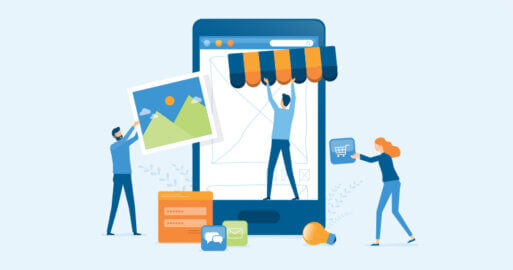How Integrating Your B2B Online Shop Takes It to the Next Level

As digitalization continues to advance, B2B web shops are also picking up speed. After Covid hit in 2020, everyone has realized that an online store is an indispensable sales channel. B2B e-stores offer countless opportunities to increase reach through direct selling. At the same time, manufacturers benefit from better margins and higher customer loyalty compared to selling through more traditional retail outlets.
However, not all of these projects are crowned by success from the start. Creating the right infrastructure for a B2B online shop is complicated and complex. As a manufacturer, you have invested a lot of time and money in launching your own B2B web shop. You then observe that although several people visit the site to browse, very few business customers actually place an order. Why is that? Although manufacturers have often supported classic, digital EDI connections to their major customers for years, most are not prepared for exploiting the new sales channel created by their own online shop. However, with a few targeted measures from the very beginning, you can avoid falling into this trap.
Automate the processes in your B2B online store with intelligent integration
With an online store you have a modern complement to standard Electronic Data Interchange (EDI), with the significant bonus that now individual employees can place orders by themselves, ad hoc, and with the help of visualized data.
It is important that online orders are automatically logged in the customer’s purchasing system. Integrating these systems is particularly important to avoid redundant orders and to enable automated processing. Primarily, this means invoicing and payment processes, but also shipment tracking to help the customer plan their production schedule or quotations for their own customers.
It goes without saying that your online orders also need to be automatically logged in your own, integrated ERP system. You will also want to fill your shop with high resolution images and comprehensive product details, customer-specific pricing and current stock levels. These aspects are crucial, not only to give your customers the knowledge to place a considered order, but to also know when their goods will arrive. It would therefore be beneficial to connect the shop over a central hub to relevant business software such as your ERP system, PIM and CRM software, and your warehouse system/s, as well as logistics providers. Did you know that SEEBURGER offers a wide range of e-commerce connectors and partner profiles that make integration simple and cost-effective?
Case Study
Discover how cosmetics company ARTDECO uses the SEEBURGER Business Integration Suite to optimally integrate its B2B web shop and successfully pursue individual sales strategies.
If you want to enable your customers to automatically log their orders from your online shop into their own purchasing system (triggering further automated processing on their side), you have the following avenues open to you:
a) Customers order through OCI catalogue access and PunchOut from their own SAP ERP system
Your customer’s employees access the catalogue behind your web shop from their SAP ERP or SAP SRM system using an interface called Open Catalogue Interface (OCI). This was developed by SAP to call up external product catalogues from within an SAP system. Also known as PunchOut, it makes an OCI call over XML. This causes the catalogue to open in a new browser window and the chosen products are transferred to a shopping cart within SAP using internet protocols. This triggers an order in SAP, which is communicated to you via EDI. The catalogue’s content is customer-specific and kept right up to date.
Any further B2B business processes are automatically triggered and efficiently processed on both sides. This option is particularly interesting for business customers who want to store catalogues from a range of manufacturers in their SAP system. This, of course, gives them a wider product range from which they can purchase. You will need to define the API for your shop, while your customer will be responsible for the OCI integration in their SAP system. Orders are processed in batch at scheduled intervals.
As the operator of your online shop, you will only receive orders once the B2B/EDI data has been transferred. You will not be able to use this data to measure traffic to your site. Only customers who use a SAP system with inventory management will be able to access your catalogue in this way. Similar access options may be available for other ERP systems, however, there is no common interface.

b) An API lets customers automatically log their online orders in their choice of ERP system.
Since not all your potential customers will be using SAP as their ERP system, make sure you offer other ways for them to automate their ordering process. An ideal solution would be an Application Programming Interface (API) that can be used by all of your customers.
This means not only connecting your web store to your business applications using the API capabilities on an integration platform, but also providing your customers with a corresponding API. Therefore, when customers place an order in your B2B online shop, you not only send it to your own ERP (such as SAP), but also enable the customer to automatically log their orders in their own ERP system using a REST API in JSON format. Thanks to your integrated business applications, online orders draw on the most up-to-date inventory, price and product data. Equally, you are able to view order history and usage of your online shop in a quantifiable way. Onboarding new API partners doesn’t have to be difficult if you use a community management application such as that offered by SEEBURGER.
The customer would also immensely benefit from an integration platform or cloud-based integration services (such as those from SEEBURGER) to enable automatic logging in their purchasing system. They would then benefit from their order (almost) immediately appearing in their ERP for further processing.
If your customer supports B2B/EDI, this can also be used for all subsequent processes such as order confirmation, delivery notification, invoicing and payment. You can share additional tracking information in many ways, including via the online shop, by email or efficiently through an API. Depending on the technical capabilities of your customers and any processes which require further real-time information, you may wish to supplement – or even replace – B2B communication through APIs, letting customers automate processes on their in-house systems.

What is the best way to integrate your B2B online shop?
In short, both variants have their place. Option b can be used more comprehensively due to optimal shop use, non-dependency of a customer’s ERP system and its automated onboarding support. The workload is also significantly lower in this approach, as you are not permanently responsible for updating the OCI catalogue. APIs let customers call up their orders and enable customers using a wide range of ERP systems to automate logging their orders in their systems.
As modernizing systems happens at different paces, it’s important for you, the product manufacturer, to be able to map and monitor both API and EDI communication. Preferably cost efficiently on one platform.
Make a success of your B2B online store with comprehensive, flexible integration
The success of a B2B web shop really hinges on it being seamlessly integrated into your and your customers’ IT systems. Both REST APIs and the classic B2B/EDI play important roles in this. If you or your customers don’t have the integration knowledge and experience needed to make a success of this, there are digitisation partners who can implement all that you need to harness the full potential of your B2B online shop.
This includes:
-
B2B/EDI Integration
A B2B/EDI solution lets you map business processes with your customers for after they’ve placed an online order. If you have already used B2B/EDI with your customer, this is a doddle. If you need further help and resources, SEEBURGER offers B2B/EDI in licence, rental and cloud service models.
-
API/EAI Integration
Use REST APIs to connect your B2B online shop to all your relevant business applications. This ensures that customers are making their purchasing decisions based on up-to-date data, with continually monitored processes, including the integration of your online business into your ERP (such as SAP).
-
API provisioning
Provision an API to enable your customers to call up orders in a safe and controlled way, automated and digital, regardless of which ERP they use. This allows customers to order from your B2B web shop at any time and from anywhere. Automating order processing is crucial, but may need to be supplemented with further information about the order and/or delivery by API. This may be especially true for start-ups that often initially have a comprehensive e-commerce application with sufficient ERP, yet only API functionality.
Ideally, you will be using an integration platform which supports all your processes. Therefore, whether you deploy this platform as fully-managed cloud services or as an on-premises installation in a private or public cloud, or even on hardware, you can be sure that your legacy applications and cloud applications are intelligently interconnected and your processes are being comprehensively monitored.
Further benefits of integrating your B2B online store
Profit from your integration and automation work with a range of further benefits:
- Growing acceptance of your B2B web shop
- More targeted product positioning thanks to customer-specific data
- Higher order rate through web shop
- Faster purchasing and logistics processing.
Would you like to know more? In our on-demand webcasts, SEEBURGER e-commerce experts look at how to make a success of your e-commerce ventures through the seamless integration of your B2B online sales portal with relevant business applications.
Thank you for your message
We appreciate your interest in SEEBURGER
Get in contact with us:
Please enter details about your project in the message section so we can direct your inquiry to the right consultant.
Written by: Patrizia Sauer
Patrizia Sauer has been Business Development Manager at SEEBURGER for CPG/Retail since 2014. She focuses mainly on e-commerce solutions, customer and partner support in this environment, and innovations for the digitalization of functional and technical business processes. Ms. Sauer is a manager of industrial engineering specializing in online sales & marketing, and has multiple years of professional experience in the software industry and digital trade, having worked for seven years prior thereto at Amazon EU.





